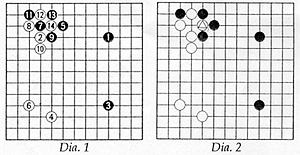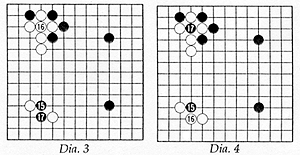Go and intellectual development in children
Recently, the educational value of games and their role in developing intelligence in children have come to be appreciated. A number of studies in the West have shown that playing chess aids not only the early development of the brain but also benefits young players socially, builds character and contributes to overall classroom performance. Unfortunately, all the research done on this subject in the West has neglected go, the one game that has the most pronounced effect on intelligence. Why does go enhance a young person's education?A number of Japanese psychologists have done extensive testing on children who play go. Their research has led them to believe that a child's innate abilities are best developed by playing go. According to one researcher at Chiba University, go strategy is global in scope, so action that takes place on one part of the board affects the entire board. In contrast, a child's view of the world is narrow, but when taught to play go, a child quickly develops a broader vision of the world. These researchers also assert that the younger the child learns to play, the better the result-4 to 5 seems to be the best age to learn. At this age, a child's brain is only about 65 percent to 70 percent developed, so the benefits of go to his or her thinking processes are optimal. Moreover, the child enjoys playing go because, like all games, it is fun.
One of the benefits children get from playing go and chess is the ability to concentrate. Children usually acquire this ability by doing things that interest them. But there are different kinds of concentration: passive and active. Children may concentrate on their favorite TV programs, but this is passive concentration. When they play a game like go, however, they have to use their minds to the full. They must perform prodigious feats of memory and flex their mental muscles to keep track of the many variations they are analyzing, to visualize mentally what a hypothetical sequence will look like on the board, and to come to a decision on their move. Other endeavors in which children use their minds so intensively, while enjoying themselves so thoroughly, would be hard to find. In the end, this ability to concentrate, acquired by playing go, can be transferred to other endeavors.
When playing go, it is necessary to use both intuitive and analytical faculties. In the opening stages, there are so many ways to play that no one can say that one move is better than another. Strategic principles can guide you, but even the strongest players must ultimately rely on intuition. As the game progresses, however, analytical ability becomes more important until, in the final stages, it is the overriding factor. In contrast, chess is an analytical game from beginning to end-every move must be backed up by thorough analysis. This is why computers play chess so well but play go so badly.
Some knowledge about the brain is necessary to explain this. The brain is divided into two hemispheres. Logical and linguistic abilities are controlled in the left hemisphere. The more intuitive abilities-aptitude for music and the ability to recognize complex patterns-are controlled in the right. When a person suffers a stroke, one side of the brain is usually damaged. One study carried out on go players who have suffered strokes found that if the right hemisphere was damaged, their opening became weak, but their middle and end games remained strong. If the damage occurred on the left hemisphere, their opening strategy remained strong, but their middle and end games became weak.
The conclusion drawn by the researchers was that children who study go exercise both sides of their brains, enabling them to develop both their creative and logical abilities.
An example of ko in a game
Here is an example on a 13 x 13 board to show how a ko can arise in a game. After Black 11 in Diagram 1, White ataris the black stone at 7 with 12. Black counter-ataris with 13 and White captures with 14. The result is shown in Diagram 2.

According to the ko rule, Black cannot capture the marked stone with his next move-he must play 15 elsewhere. If Black plays 15 as in Diagram 3, White can connect at 16 and end the ko. Black will then push through with 17 and destroy the territory that White mapped out in the lower left corner.

White might not like this result, so he defends his corner against the threat of Black 15 with 16 in Diagram 4. Black can now go back and capture the ko with 17. This time it is White who cannot recapture-he must make a move elsewhere. This ko could go on for several more moves before being resolved. Victory or defeat is often decided by the outcome of a ko fight.
By Richard Bozulich
By Rob van Zeijst
- 0, Problems and answers
- 1, How go is played / Four basic rules / The object: to control territory
- 2, The origins of go / Four basic rules / The rule of capture
- 3, Go comes to Japan / Six basic rules of go / Capturing two or more stones
- 4, The development of go in Japan / Capturing stones in a game
- 5, Professional go in Japan / More about capturing
- 6, Defending territory / Illegal moves
- 7, Go in China / More on illegal moves
- 8, Go in South Korea / A review of the rules/ Eyes and living groups
- 9, International go tournaments / Eye spaces
- 10, Lee Chang Ho, Cho Chikun -- the superstars of go / False eyes
- 11, Go and computers / Seki
- 12, Rankings and handicaps / The rule of ko
- 13, Go and intellectual development in children / An example of ko in a game
- 14, Meijin title match / Double ko
- 15, Kisei title and Cho-Kobayashi rivalry/ Triple ko
- 16, Takemiya's cosmic go
- 17, Go Seigen, the 20th century's greatest player
- 18, Go equipment / How go is played / The rules / Elaboration /
- 19, Kitani and his disciples / The rule of capture
- 20, Atomic-bomb game / More on capturing stones
- 21, Dosaku and Shusaku: The saints of go
- 22, Go and the Immortals
- 23, Women in go / Capturing races
- 24, Eio Sakata / Capturing techniques
- 25, Shuko Fujisawa, the first Kisei of the modern era / Capturing techniques: Nets
- 26, Cho Chikun defends Kisei title / Illegal moves / Living groups
- 27, Opening strategy / False eyes
- 28, Joseki
- 29, Lee Chan Ho, the undisputed world go champion
- 30, Kobayashi wins Judan title
- 31, Fujitsu Cup
- 32, Tesuji and Intuition
- 33, Go and business (1)
- 34, Go and business (2)
- 35, Japan-China Tengen match
- 36, Go and war
- 37, Legends on origin of go (1)
- 38, Legends on origin of go (2)
- 39, World Amateur Go Championship
- 40, Go in Europe
- 41, Go online
- 42, Cho Chikun loses Honinbo title
- 43, The 11th TV Asia Cup
- 44, Long and short games
- 45, Fujitsu Cup
- 46, Go proverbs
